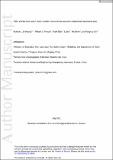Wintertime Water Mass Transformation in the Western Iceland and Greenland Seas
Author(s)
Huang, Jie; Pickart, Robert S.; Bahr, Frank; McRaven, Leah T.; Xu, Fanghua
Download10.1029-2020JC016893.pdf (4.914Mb)
Publisher Policy
Publisher Policy
Article is made available in accordance with the publisher's policy and may be subject to US copyright law. Please refer to the publisher's site for terms of use.
Terms of use
Metadata
Show full item recordAbstract
Hydrographic and velocity data from a 2018 winter survey of the western Iceland and Greenland Seas are used to investigate the ventilation of overflow water feeding Denmark Strait. We focus on the two general classes of overflow water: warm, saline Atlantic-origin Overflow Water (AtOW) and cold, fresh Arctic-origin Overflow Water (ArOW). The former is found predominantly within the East Greenland Current (EGC), while the latter resides in the interior of the Iceland and Greenland Seas. Progressing north to south, the properties of AtOW in the EGC are modified diapycnally during the winter, in contrast to summer when along-isopycnal mixing dominates. The water column response to a 10-days cold-air outbreak was documented using repeat observations. During the event, the northerly winds pushed the freshwater cap of the EGC onshore, and convection modified the water at the seaward edge of the current. Lateral transfer of heat and salt from the core of AtOW in the EGC appears to have influenced some of this water mass transformation. The long-term evolution of the mixed layers in the interior was investigated using a 1-D mixing model. This suggests that, under strong atmospheric forcing, the densest component of ArOW can be ventilated in this region. Numerous anti-cyclonic eddies spawned from the EGC were observed during the winter survey, revealing that these features can play differing roles in modifying/prohibiting the open-ocean convection.
Date issued
2021-07-14Department
Woods Hole Oceanographic InstitutionJournal
Journal of Geophysical Research: Oceans
Publisher
American Geophysical Union (AGU)
Citation
Huang, J., Pickart, R. S., Bahr, F., McRaven, L. T., & Xu, F. (2021). Wintertime water mass transformation in the western Iceland and Greenland Seas. Journal of Geophysical Research: Oceans, 126, e2020JC016893.
Version: Author's final manuscript
ISSN
2169-9275
2169-9291